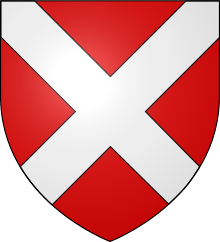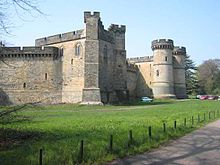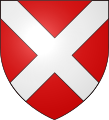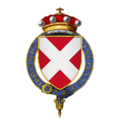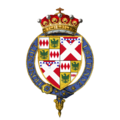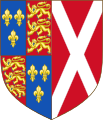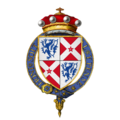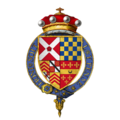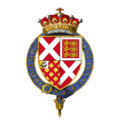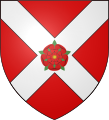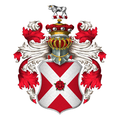House Neville
The House of Neville (later Nevill ) is a noble family of early medieval origins that was a leading force in English politics in the later Middle Ages. The family became one of the two centers of power in northern England and, along with their rival, the House of Percy , played a central role in the Wars of the Roses .
origin
The Nevilles are seen as a branch of the House of Dunkeld , as descendants of Crínán († 1045), the hereditary lay abbot of Dunkeld . The lineage is only secured from the 5th generation with Dolfin, son of Uhtred, who received Staindrop in County Durham from Prior Algar of Durham in 1131 and paid homage to him, but also to the King of England and the King of Scotland. Since most of the Anglo-Saxon aristocracy of England was expropriated after the Norman conquest and replaced by a new Norman elite, the continuity that is emerging here is unusual, even if it is more common in the far north of England than in the south. Staindrop remained the main seat of the family until 1569: the main residence was Raby in the north of the parish of Staindrop, where Raby Castle was built in the 14th century .
Dolfin's grandson Robert FitzMaldred married the Anglo- Norman heiress Isabel de Neville, daughter of Geoffrey de Neville , 2nd Baron of Ashby in Lincolnshire . Their son Geoffrey "de Neville" († around 1242) inherited the lands of both the maternal and the paternal family, took the surname of the mother, but kept the paternal coat of arms.
The way to power
The family's wealth and power grew steadily in the centuries that followed. Her regional position benefited greatly from frequent appointments to royal offices such as Sheriff , Castellan , Justice of the Forest and Justice of the Peace in various parts of northern England. These offices began with Geoffrey de Neville's son Robert under Henry III. of England , which Robert supported against the aristocratic opposition led by Simon de Montfort ( Second War of the Barons ). Robert's grandson Ranulph Neville became one of the founding members of the Peerage of England when he was appointed to the House of Lords in 1295, starting with the Barons Neville de Raby .
Service in the wars against Scotland in the late 13th and 14th centuries, and later in the Hundred Years War in France, was central to the continued rise of the family's reputation. In 1334, Ralph Neville, Lord of Raby, was named one of the Warden of the Marches , in command of the border defense, and it was often Nevilles who later took over the post. Ralph commanded the army that defeated the Scots at the Battle of Neville's Cross near Durham in 1346 and captured King David II of Scotland . In the mid-14th century, the Neville were also entrusted with naval defense when they were given the office of Admiral of the North . From this time they were also used for court and church offices, when the winner of Neville's Cross was appointed Steward of the Royal Household and his son John Neville succeeded him in this office after his death (1368) ; John's brother Alexander Neville became Archbishop of York in 1374 and was a close adviser to King Richard II , but prosecuted along with Richard's other leading supporters when the Lords Appellant exercised power in 1386/96. His property was confiscated, but as a clergyman he escaped the death sentences of his colleagues.
By the end of the 14th century, the family had acquired a wide variety of lands in northern England. In addition to their original power base in County Durham, they had extensive land holdings in north and central Yorkshire, as well as in Cumberland and Northumberland , and occasionally in Lancashire , Lincolnshire , Norfolk , Northamptonshire , Bedfordshire and Essex . They acquired or built important castles in Brancepeth near Durham and in Middleham , Sheriff Hutton and Snape in Yorkshire.
Earls of Westmorland
The Nevilles belonging to the highest ranks of the nobility was officially recognized in 1397 when Richard II made Ralph Neville Earl of Westmorland . At the time, the power of the Nevilles in the north was surpassed only by the House of Percy , the Earls of Northumberland , and a fierce rivalry developed. These rival magnates of the north enjoyed an exceptional degree of autonomy over royal authority due to the remoteness and insecurity of the region in which they were established. The king, whose court was located in the south, had to rely on the powerful lords of both houses to protect the border from a Scottish invasion, to balance the mutual influence and to assist with general government business.
Although the family had previously been close to Richard II, Earl Ralph quickly joined Henry of Bolingbroke when he landed in England in 1399 to overthrow Richard: Westmorland was married to Joan Beaufort , Henry's half-sister. Henry expanded Richard II's policy to strengthen the Nevilles 'power to control the pesky Percys, and the Nevilles benefited from the Percys' weakening by the Crown's suppression of a series of insurrections in which the Percys were involved.
While the royal marriage raised the Nevilles' political standing, it led to a serious split in the family. Earl Ralph had previously been married to Margaret Stafford, and the title of Earl of Westmorland passed to his son from that marriage. However, he preferred his sons from his second marriage, who received most of the inheritance upon his death. This resulted in bitter disputes and permanent alienation between the Nevilles of Raby, descended from Margaret Stafford, and the Nevilles of Middleham, descended from Joan Beaufort.
In addition to his inheritance, Ralph's eldest son of Joan Beaufort, Richard Neville , received the Earldom of Salisbury through marriage to his heiress. Salisbury's eldest son Richard became Earl of Warwick in the same way . These marriages added vast amounts of land to the family: those in County Warwick inherited from the Beauchamp family were concentrated mainly in Warwickshire and Worcestershire , with properties in County Durham, Devon , Cornwall and the Welsh Marches . The main Salisbury estates, formerly held by the Montagus, were in the south-west with clusters in Devon, Dorset , Somerset and Wiltshire . The family also acquired the Latimer Barony , the Fauconberg Barony and the Bergavenny Barony , which were passed on to younger sons.
Wars of the Roses
Supporters of York
Salisbury and Warwick were major supporters of Richard Plantagenet, 3rd Duke of York , in the early stages of the Wars of the Roses . They probably expected that a York seizure would bring about a favorable settlement of the family inheritance disputes and the dispute with the Percys for supremacy in the north. They were also linked by marriage to York, since he had married Salisbury's sister Cecily Neville : among their common children were the future kings Edward IV and Richard III. In addition to their own wealth and armed following, the weight of the Nevilles in this and subsequent conflicts was reinforced by Warwick's position as Constable of Calais and Commissioner for the keeping of the seas : these offices gave him command of England's only significant standing force and control of a war fleet; they also enabled him to develop close relationships with the London Merchants of the Staple , a major source of their financial support, as well as gaining popularity with the discontented populations of London and the south-east, particularly Kent , whom Warwick and his allies repeated to the Incited a riot. York and Salisbury were killed in the Battle of Wakefield in 1460 , but Warwick helped York's son Edward, Earl of March , Henry VI. to depose and in 1461 to ascend the throne as Edward IV.
Among the family's rewards for their support was the elevation of Salisbury's brother William Neville, Lord Fauconberg, to the Earl of Kent . He, Warwick, and Salisbury's younger son John Neville , now elevated to Baron Montagu, directed the repression of the House of Lancaster's continued resistance to the north, where the displaced dynasty endured for three years after their decisive defeat at the Battle of Towton in 1461 . The Percys were among the most important supporters of Lancaster and with the death of Henry Percy, 3rd Earl of Northumberland in Towton and the final elimination of the resistance in the north in 1464, the Nevilles triumphed over their rivals and were able to acquire the Earldom Northumberland for John Neville in 1465 .
Dissatisfaction and apostasy
Warwick, now the richest man in England after the king, was the power behind the throne in Edward's reign in the early years, but the two men fell out some time later: their estrangement was largely due to the king's secret marriage in 1464 Attributed to Elizabeth Woodville . This humiliated Warwick, who with Louis XI. of France had negotiated an agreement according to which Eduard Bona of Savoy (daughter of Duke Ludwig and later wife of Galeazzo Maria Sforza , Duke of Milan ) should marry, the sister-in-law of the French king. The disruption of relations was exacerbated by the later influence of the Woodvilles, who successfully turned against Warwick's foreign policy.
In 1469 Warwick took control of the government together with his brother George Neville , the Archbishop of York , and Edward's brother George Plantagenet, 1st Duke of Clarence : their alliance had been strengthened by Clarence's marriage to Warwick's daughter Isabel Neville . The king was imprisoned in Middleham Castle, but the attempt to rule on his behalf failed because the new regime could not enforce its authority, and Edward had to be released in October. The king refrained from punishing the rebels, but attempted to rebalance the Nevilles to the north by returning the county of Northumberland to the dispossessed heir Henry Percy - thus John Neville, who had remained loyal to the king when his brothers rebelled , his title, his land and his offices have been withdrawn. Eduard tried to maintain John's allegiance by compensating him with lands in the southwest, the new title Marquess of Montagu, and the engagement of his young son George Neville to his eldest daughter (and current heiress) Elizabeth of York . George was made Duke of Bedford in recognition of his future prospects. Obviously, none of this could appease Montagu.
Warwick and Clarence rebelled again in 1470, apparently wanting to put Clarence on the throne. Defeated, they fled abroad, where they made common cause with the exiled supporters of Lancaster and married Warwick's daughter Anne Neville to Edward of Westminster , the only son of Henry VI. When Warwick and other leaders of this alliance landed in England to start another revolt, they were supported by leading nobles still in England, including Montagu, who had rallied with the troops he had nominally raised for Edward IV. now turned against the king. Eduard fled the country and Heinrich VI. was briefly put on the throne, but Eduard soon successfully counterattacked: Warwick and Montagu were killed in the Battle of Barnet in 1471 .
aftermath
Warwick and Montagu were never officially charged with the loss of their property. Even so, the victorious House of York did not allow the Nevilles inheritance process to follow normal legal channels. Montagu's estates should have passed to his son George Neville, Duke of Bedford, along with the substantial portion of Warwick's inherited possessions that had been made available to male heirs, giving Bedford precedence over Warwick's daughters. In practice, however, Bedford was denied his inheritance while his engagement to Elizabeth of York was broken off. He was eventually stripped of his title by Parliament in 1478, allegedly because he lacked the property necessary to maintain duke status.
The Middleham-Nevilles legacy, on the other hand, became the subject of disputes between King Edward's brothers, Richard, Duke of Gloucester , and Clarence, who had returned to the family's bosom prior to the Battle of Barnet. Clarence, whose claim was based on his marriage to Isabel Neville, gained counties of Warwick and Salisbury. Gloucester acquired the old Neville estates to the north and based its claim on marriage to Anne Neville, widowed after the death of Edward of Westminster in the final defeat of the Lancasters at the Battle of Tewkesbury in 1471. The land to the north, inherited from the Nevilles, and their clientele became Gloucester's main power base, and he took Middleham Castle as his primary residence until he was named Richard III in 1483. usurped the throne.
In the alienation between the two branches of the family, the Nevilles of Raby, led by Ralph Neville, Earl of Westmorland, had sided with Lancaster from the start. Westmorland's brother, John Neville, Lord of Raby, was killed in the defeat of Towton. The Earls of Westmorland line survived the wars, but the loss of most of their ancestral estates to the Nevilles of Middleham and their subsequent demise left them severely weakened.
The younger Nevilles lines also survived, including the holders of the Latimer and Bergavenny baronies in Snape and Abergavenny. Edwar Neville, Lord Bergavenny, had been forcibly robbed of his inheritance many years ago by his nephew, the Earl of Warwick. During the wars, each of these branch lines had sometimes fought with and sometimes against the main line of the Middleham-Nevilles, led by Salisbury and Warwick.
Younger story
The regional power of the northern magnates, already severely weakened by the losses in the Wars of the Roses, was further reduced by the growing power of the central government in the 16th century. In 1569, the Nevilles and Percys buried their traditional rivalry to venture a revolt of the northern earls in an attempt to overthrow Elizabeth I and replace her with the Catholic Maria Stuart . The uprising turned into a fiasco and Charles Neville, the Earl of Westmorland, fled into exile abroad. He was charged in absentia and lost his title and property. He died in 1601 with no male heirs as the last of the older Neville line.
The Latimer branch of the family was also extinct in 1577, but the Bergavenny line still exists. Following the death of Henry Nevill, 6th Baron Bergavenny, in 1587, his daughter Mary Nevill litigated to be recognized as the heir to all of Neville's remaining inheritance. Ultimately, however, these lands were divided between her and her cousin Edward Nevill, who inherited the baronial title. Her son Francis Fane inherited the very old title Baron le Despencer through her. For him, the main title of the Neville family as Earl of Westmorland was created and has remained with his male descendants ever since.
Edward Nevill's descendants were elevated to Earls of Abergavenny and Marquesses of Abergavenny. This line also still exists.
Tribe list
Origins
-
Crínán the Thane († 1045), hereditary lay abbot of Dunkeld ; ∞ Bethoc of Scotland, Lady of Atholl ( House Dunkeld )
- Duncan I († 1040) 1034 Scottish king - descendants
- Maldred († probably 1045), Lord of Allerdale, Regent of Strathclyde 1034/35; ∞ probably before 1040 Ealdgyth, daughter of Uhtred , Earl of Northumbria , and Ælfgifu of England
- Gospatrick (* probably 1040/48; † probably 1075), from December 1067 Earl of Northumberland - descendants
- Maldred
- Robert
- Uhtred († November 6th ...)
- Dolfin, received Staindrop from the Prior of Durham
in 1131
- Meldred FitzDolfin
- Robert FitzMaldred († between June 25, 1242 and May 26, 1248) Lord of Raby and Brancepeth; ∞ Isabel de Neville († before May 1254), daughter of Geoffrey de Neville and Emma de Bulmer, she married Gilbert de Brankenberg for the second time
- Geoffrey FitzRobert de Neville († 1242); ∞ Joan
-
Robert de Neville († before August 20, 1282); ∞ (1) NN; ∞ (2) Ida, widow of Robert Bertram of Mitford
- (1) Robert de Neville († August 6, 1271), buried in Coverham Abbey ; ∞ probably 1260 Mary († 1320) daughter of Ralph FitzRandolph of Middelham and Anastasia de Percy
- Ranulph Neville († April 18, 1331) 1305 Lord Neville of Raby, buried in Coverham Abbey; ∞ (1) Eupheme, daughter of Robert FitzRoger; ∞ (2) Margery, daughter of John de Thweng - descendants see below
- Robert de Neville
- Ralph Neville, cleric
- Margaret Neville; ∞ Gilbert Wa ... ton
- Joan, Anastasia, Henry and Ranulph Neville
- (1) John de Neville
- (1) Robert de Neville († August 6, 1271), buried in Coverham Abbey ; ∞ probably 1260 Mary († 1320) daughter of Ralph FitzRandolph of Middelham and Anastasia de Percy
- Agnes de Neville († between June 16, 1285 and July 20, 1293); ∞ (1) Richard de Percy of Topcliffe († 1244), son of Joscelin de Louvain and Agnes de Percy ( House of Percy ); ∞ (2) before November 12, 1251 John (II.) Deincourt († 1257), son of Oliver (II.) De Aincourt and Nicole
- Geoffrey de Neville († before 1285); ∞ Margaret († 1319), daughter of John de Lungvillers
- John Neville (* 1269; † probably 1309) of Hornby; ∞ Pernel († probably 1346/49)
- John Neville († 1335)
- Geoffrey Neville
- Robert Neville
- Robert Neville (* before 1312; † 1342); ∞ (1) Joan, daughter of Henry of Atherton; ∞ (2) Elizabeth de St Lawrence, daughter of Thomas de St Lawrence, widow of Roger de Kirby
- Robert Neville († 1413): ∞ 1344 Margaret de La Pole, daughter of William de La Pole and Catherine
- Thomas Neville († before 1387) of Hornby
- Margaret Neville (* probably January 1377 or 1383; † probably 1413/26, probably before April 4, 1424), buried in Bury St Edmunds Abbey; ∞ before February 15, 1404 Thomas Beaufort († December 31, 1426 East Greenwich Manor), July 5, 1412 Earl of Dorset , November 18, 1416 Duke of Exeter , son of John of Gaunt, 1st Duke of Lancaster , and Catherine Swynford , buried in Bury St Edmunds Abbey ( Plantagenet House )
- Thomas Neville († before 1387) of Hornby
- John, Giles, Thomas, William and Gilbert Neville
- Robert Neville († 1413): ∞ 1344 Margaret de La Pole, daughter of William de La Pole and Catherine
- Robert Neville (* before 1312; † 1342); ∞ (1) Joan, daughter of Henry of Atherton; ∞ (2) Elizabeth de St Lawrence, daughter of Thomas de St Lawrence, widow of Roger de Kirby
- Edmund and William Neville
- John Neville (* 1269; † probably 1309) of Hornby; ∞ Pernel († probably 1346/49)
- John Neville, cleric
-
Robert de Neville († before August 20, 1282); ∞ (1) NN; ∞ (2) Ida, widow of Robert Bertram of Mitford
- Geoffrey FitzRobert de Neville († 1242); ∞ Joan
- Robert FitzMaldred († between June 25, 1242 and May 26, 1248) Lord of Raby and Brancepeth; ∞ Isabel de Neville († before May 1254), daughter of Geoffrey de Neville and Emma de Bulmer, she married Gilbert de Brankenberg for the second time
- Patrick
- Meldred FitzDolfin
- ? Gospatrick, attested in 1124
- Godereda († after 1129)
- Dolfin, received Staindrop from the Prior of Durham
in 1131
The Neville de Raby
-
Ranulph Neville († April 18, 1331) 1305 Lord Neville of Raby, buried in Coverham Abbey ; ∞ (1) Eupheme, daughter of Robert FitzRoger; ∞ (2) Margery, daughter of John de Thweng - ancestors see above
- (1) Robert Neville († 1319); ∞ Elena / Ellen
- (1) Anastasia Neville
- (1) Ralph Neville (* probably before 1291; † August 5, 1368), Lord Neville, buried in Durham ; ∞ 1327 Alice de Audley, daughter of Hugh Audley , and Isolt de Mortimer, sister of Hugh de Audley, 1st Earl of Gloucester , widow of Ralph de Greystoke, Lord Greystoke
- Margaret Neville († May 1372); ∞ (1) before May 8, 1341 William de Ros (* May 19, 1329 Frieston ; † before December 3, 1352), son of William de Ros and Margery de Badlesmere; ∞ (2) July 12, 1358 Brancepeth Henry de Percy (born November 10, 1341 - † February 19, 1408 at the Battle of Bramham Moor ), 1368 Lord Percy, 1377 Earl of Northumberland, son of Henry Percy, Lord Percy , and Mary of Lancaster , buried in York Minster ( House Percy )
- Catherine Neville († 1361); ∞ before 1339 William de Dacre (* probably 1319; † July 18, 1361), 1330 Lord Dacre, son of Randolf de Dacre, Lord Dacre of Gilsland, and Margaret de Multon of Gilsland, buried in Lanercost Priory
- Euphemia Neville († 1393, probably October / November); ∞ (1) 1343 Robert Clifford, Lord Clifford (* probably 1327/28; † 1350, before November 7, in France), son of Robert de Clifford, Lord Clifford, and Isabel de Berkeley; ∞ (2) early in 1347 Reginald de Lucy († 1362/65), son of Thomas, Lord Lucy, and Margaret de Multon; ∞ (3) Walter de Heslarton
-
John Neville (* 1341; † 1388), Lord Neville; ∞ (1) Matilda Percy († before February 18, 1378), daughter of Henry Percy, Lord Percy , and Idonia de Clifford ( House of Percy ); ∞ (2) Elizabeth, daughter and heiress of William, Lord Latimer
- (1) Alice Neville († June 20, 1433); ∞ William Deincourt (born December 26, 1357 - † October 15/16, 1381), Lord Deincourt , son of William Deincourt and Margaret de Welle of Well
- (1) Matilda Neville; ∞ William Le Scrope
-
Ralph Neville (probably 1364 - 21 October 1425 Raby Castle), 1388 Lord Neville, 29 September 1397 1st Earl of Westmorland, 30 September 1399 Marshal of England, joined as Marshal no later than 1413 for the benefit of his son-in-law John, Earl of Norfolk, back, December 1422 on the council of Regent Humphrey, Duke of Gloucester , buried at Staindrop; ∞ (1) Margaret Stafford († June 9, 1396), daughter of Hugh Stafford, 2nd Earl of Stafford , and Philippa de Beauchamp of Warwick; ∞ (2) before November 29, 1396 Joan Beaufort (probably 1379 - November 13, 1440 Howden ), daughter of John of Gaunt, 1st Duke of Lancaster , and Catherine Swynford , sister of King Henry V ( House of Plantagenet ), Widow of Robert Ferrers of Willisham
- (1) Matilda Neville († October 1438), buried in the Dominican Church of Scarborough ; ∞ before August 6, 1400 Piers de Mauley, Lord Mauley (probably 1378 - September 6, 1415), son of Piers de Mauley and Margery de Sutton
- (1) Alice Neville; ∞ (1) Thomas Gray of Heton; ∞ (2) Gilbert Lancaster
- (1) Philippa Neville († before 1458); ∞ before 1399 Thomas de Dacre, Lord Dacre of Gilsland (* October 27, 1387 Naworth Castle ; † January 5, 1458), son of William de Dacre, Lord Dacre , and probably Joan Douglas, buried in Lanercost Priory
- (1) John Neville (* probably 1387; † May 1420), Lord Neville; ∞ 1394 Elizabeth de Holand, daughter of Thomas de Holand, Earl of Kent , and Alice FitzAlan of Arundel ( House of Holland ) - descendants see below
- (1) Elizabeth Neville
- (1) Anne Neville; ∞ before February 3, 1413 Gilbert de Umfraville of Harbottle (born October 18, 1390 Harbottle Castle ; † March 22, 1421 at the Battle of Baugé ), son of Thomas Umfraville of Harbottle and Agnes
- (1) Ralph Neville († 1458); ∞ Mary Ferrers (* probably 1394; † 1458), daughter and heiress of Robert Ferrers and Joan Beaufort
- (1) Margaret Neville († probably between March 4, 1463 and March 3, 1464), buried in Clare (Suffolk) ; ∞ (1) before December 31, 1413 Richard Le Scrope (May 31, 1394 - August 29, 1420), Lord Scrope (of Bolton) , son of Roger Le Scrope, Lord Scrope, and Margaret Tibetot; ∞ (2) before November 5, 1427 William Cressener of Sudbury
- (2) Joan Neville, nun, abbess at Barking
- (2) Richard Neville (1400 - December 30, 1460 in the Battle of Wakefield ), 1428 Earl of Salisbury, buried in Bisham Abbey ; ∞ February 1421 at the latest Alice de Montagu († 1462, probably between April 3 and December 9), 1428 Countess of Salisbury, daughter of Thomas Montagu, 4th Earl of Salisbury , and Eleanor de Holand of Kent - descendants see below
- (2) Katherine Neville (* probably 1402/03; † after 1483); ∞ (1) (permission January 12, 1412) John Mowbray (* 1392; † 1432, probably October 19), Earl and April 30, 1425 2nd Duke of Norfolk, son of Thomas Mowbray, 1st Duke of Norfolk , and Elizabeth Fitzalan of Arundel, buried at Epworth Priory ( House Mowbray ); ∞ (2) Thomas Strangeways; ∞ (3) after 1442 John Beaumont, 1st Viscount Beaumont (* probably 1408/09; † July 10, 1460 at the Battle of Northampton ), son of Henry Beaumont, Lord Beaumont, and Elizabeth Willoughby; ∞ (4) after 1464 John Wydeville (* probably 1445; † executed August 12, 1469 in Kenilworth ), son of Richard Wydeville, Earl Rivers , and Jacquette de Luxembourg , brother of Elizabeth Wydeville , wife of King Edward IV.
- (2) Henry, Thomas and Cuthbert Neville († young)
- (2) Eleanor Neville († 1472); ∞ (1) after May 23, 1412 Richard Le Despencer, Lord Burghersh (* 1393; † October 7, 1414 Merton (Surrey) ), son of Thomas Le Despencer, Earl of Gloucester , and Constance of York , buried in Tewkesbury Abbey ; ∞ (2) 1414 Henry Percy, 2nd Earl of Northumberland (1393 - 22 May 1455 at the First Battle of St Albans ), son of Henry Percy , called Hotspur , Lord Percy, and Elizabeth Mortimer ( House Percy )
- (2) Robert Neville († 1457), 1427–1438 Bishop of Salisbury , 1437–1457 Bishop of Durham
- (2) William Neville (* around 1405; † January 9, 1463 probably at Alnwick Castle ), 1461 Earl of Kent, buried in Gisborough Priory ; ∞ before April 28, 1422 Joan Baroness Fauconberg (born October 18, 1406 Skelton (Yorkshire) , † December 11, 1490), daughter of Thomas de Fauconberg of Skelton , Lord Fauconberg , and Joan Brounflete of Londesborough, she married John in a second marriage Berwyke
- Joan Neville (* probably 1435; † after February 22, 1472); ∞ before 1463 Edward Beethum of Beetham († February 22, 1472)
- Elizabeth Neville (* probably 1435; † before 1488); ∞ Richard Strangways of West Harlsey († April 13, 1488)
- Alice Neville (* 1437; † before 1490); ∞ before 1463 John Conyers († July 26, 1469 at the Battle of Edgecote Moor ), son of John Conyers of Hornby
- (illegitimate, mother unknown) Thomas Fauconberg († executed 1471, probably in September)
- (illegitimate, mother unknown) William Neville († after 1482)
- (2) Anne Neville († September 20, 1480), bestettate in Pleshey ; ∞ (1) before October 18, 1424 Humphrey Stafford (* 1402; † July 10, 1460 at the Battle of Northampton ), Earl of Stafford, then Duke of Buckingsham, son of Edmund de Stafford , Earl of Stafford and Anne of Gloucester , buried in the Franciscan Church in Northampton ; ∞ (2) 1467 before November 25, Walter Blount, Lord Mountjoy (* probably 1420, † August 1, 1474), son of Thomas Blount and probably Margarete Gresley, buried in the Franciscan Church in London
- (2) John Neville († young)
- (2) George Neville († December 30/31, 1469), 1432 Lord Latimer, buried in Well (North Yorkshire) ; ∞ before February 13, 1437 Elizabeth de Beauchamp (* probably 1417; † before October 2, 1480), daughter and heiress of Richard Beauchamp, Earl of Warwick , and Elizabeth Berkeley , Baroness Berkeley, she married Thomas Wake of Blisworth ( † May 20, 1476) - For descendants see below
- (2) Cicely Neville (* May 3, 1415 Raby Castle; † May 31, 1495 Berkhamsted Castle ), as a widow Benedictine, buried in the collegiate church of Fotheringhay Castle ; ∞ before October 18, 1424 Richard, Duke of York (* September 21, 1411; † December 30, 1460 at the Battle of Wakefield ), son of Richard of Conisburgh, 1st Earl of Cambridge , and Anne Mortimer ( House Plantagenet )
- (2) Edward Neville († October 18, 1476) Lord Abergavenny (iure uxoris); ∞ (1) before October 18, 1424 Elizabeth de Beauchamp (* September 16, 1415 Hanley Castle ; † June 18, 1448), Baroness Abergavenny, daughter of Richard de Beauchamp, Earl of Worcester , and Isabel Le Despencer, buried in the Carmelites -Church in Coventry ; ∞ (2) 1448 Catherine Howard († 1478), daughter of Robert Howard of Stoke Neyland and Margaret Mowbray of Norfolk - descendants: the other Barons Bergavenny, the Earls Abergavenny (from 1784) and the Marquesses Abergavenny (since 1876)
- (1) Idonia Neville
- (1) Eleanor Neville († after 1441); ∞ Ralph de Lumley, Lord Lumley († executed January 1400), son of Marmaduke de Lumley and Margaret de Holand
- (1) Thomas Neville († March 14, 1407), buried in Worksop Priory ; ∞ (1) before July 1, 1379 Joan de Furnivalle (* 1368; † before 1401), Baroness Furnivalle, daughter of William de Furnivalle, Lord Furnivalle, and Thomasine de Dagworth of Dagworth, buried in Worksop Priory; ∞ (2) 1401, probably between March 8 and July 4 Ankaret Lestrange (* probably 1361; † June 1, 1413), Baroness Strange, daughter of John Lestrange, Lord Strange of Blackmere, and Mary FitzAlan of Arundel, widow of Richard Talbot, Lord Talbot
- Matilda Neville (* probably 1392; † probably 1423), Baroness Furnivalle, buried in Worksop Priory; ∞ March 12, 1407 John Talbot (* 1384 - † July 17, 1453 in the Battle of Castillon ), son of Richard Talbot, Lord Talbot, and Ankaret Lestrange Baronesse Strange, buried in St Alkmund's Church, Whitchurch
- (2) John Neville († 1430), Lord Latimer
- Robert Neville
- Alexander Neville (around 1340 - May 1392) 1374–1388 Archbishop of York
- Thomas Neville, Elect of Ely
- William Neville (c. 1341 - October 19, 1391), Constable of Nottingham Castle ; ∞ (1) Elizabeth Le Waleys; ∞ (2) Alice de St Philbert
- Ralph Neville de Condale - descendants: the Neville of Thornton Bridge
- Eleanor Neville; ∞ Geoffrey Le Scrope (* probably 1342; † at the siege of Piskre Castle, Lithuania), son of Henry Le Scrope, Lord Scrope (of Masham), and Joan (Agnes)
- Mary Neville
- Alexandra Neville de Raskell
- John, Joan, Margaret and Alice Neville
- Thomas Neville, Archdeacon of Durham
- Anastasia Neville secunda
- William Neville
The Earls of Westmorland
-
John Neville , Lord Neville; ∞ 1394 Elizabeth de Holand, daughter of Thomas de Holand, Earl of Kent , and Alice FitzAlan of Arundel ( House of Holland ) - ancestors see above
-
Ralph Neville (* 1406; † 1484), 1425 Earl of Westmorland; ∞ (1) (marriage contract May 7, 1426) Elizabeth Percy († October 26, 1437), daughter of Henry Percy Hotspur and Elizabeth Mortimer of the Earls of March, widow of John de Clifford, Lord Clifford; ∞ (2) 1442 Margaret Cobham († probably 1466/71), daughter of Reginald Cobham
- (1) John († March 7, 1450), Lord Neville; ∞ (1) 1441 Anne de Holand († December 26, 1486), daughter of John de Holand, Duke of Exeter , and Anne Stafford, she married John Neville, the uncle of her first husband, in 1452, and James in third marriage Douglas, 9th Earl of Douglas
- (2) Margaret († young)
- ? (illegitimate, mother unknown) George Neville; ∞ after 1483 Mary, daughter of Henry FitzLewis and Elizabeth Beaufort, widow of Anthony Wydeville, Earl Rivers
-
John Neville († March 29, 1461 at the Battle of Towton ), Lord Neville; ∞1452 Anne de Holand († December 26, 1486), daughter of John de Holand, Duke of Exeter , and Anne Stafford, widow of his nephew John Neville, Lord Neville, she was third married to James Douglas, 9th Earl of Douglas
- Ralph Neville (1456–1523) Earl of Westmorland; ∞ 1473 Isabel Booth, daughter of Roger Booth - descendants: the later Earls of Westmorland (forfeited 1571, † 1601)
-
Ralph Neville (* 1406; † 1484), 1425 Earl of Westmorland; ∞ (1) (marriage contract May 7, 1426) Elizabeth Percy († October 26, 1437), daughter of Henry Percy Hotspur and Elizabeth Mortimer of the Earls of March, widow of John de Clifford, Lord Clifford; ∞ (2) 1442 Margaret Cobham († probably 1466/71), daughter of Reginald Cobham
The kingmaker and his family
-
Richard Neville (1400 - December 30, 1460 at the Battle of Wakefield ), 1428 Earl of Salisbury, buried in Bisham Abbey ; ∞ February 1421 at the latest Alice de Montagu († 1462, probably between April 3 and December 9), 1428 Countess of Salisbury, daughter of Thomas Montagu, 4th Earl of Salisbury , and Eleanor de Holand of Kent - ancestors see above
- Joan Neville († before September 9, 1462), buried in Arundel , ∞ after August 17, 1438 William FitzAlan, 16th Earl of Arundel (* November 23, 1417; † 1487), son of John FitzAlan, 13th Earl of Arundel and Eleanor Berkeley, buried in Arundel ( House FitzAlan )
- Eleanor Neville († before October 1473), buried in St James Garlickhythe , London; ∞ after May 10, 1457 Thomas Stanley, 1st Earl of Derby (* probably 1435; † 29, July 1504 Lathom House ), son of Thomas Stanley, Lord Stanley , and Joan Goushill of Hoveringham, buried in Burscough Priory
-
Richard Neville (1428 - April 14, 1471 at the Battle of Barnet ), 1449 Earl of Warwick (uxor nomine), 1460 Earl of Salisbury; ∞ 1434 Anne Beauchamp (1426, probably in April, in Caversham Park ; † before September 20, 1492), 1449 Countess of Warwick, daughter of Richard Beauchamp, 13th Earl of Warwick , and Isabel le Despenser, 5th Baroness Burghersh
- Isabel Neville (September 5, 1451 Warwick Castle ; † December 22, 1476 the.), Buried in Tewkesbury Abbey ; ∞ July 11, 1469 Notre-Dame de Calais George Plantagenet (October 21, 1449 Dublin Castle ; † murdered February 18, 1478 Tower of London ), 1461 Duke of Clarence, 1472 Earl of Salisbury and Earl of Warwick, son of Richard Plantagenet, 3. Duke of York and Cecily Neville of Westmorland ( House Plantagenet )
- Anne Neville (born June 11, 1456 Warwick Castle , † March 16, 1485 Westminster Palace ) buried in Westminster Abbey ; ∞ (1) August or December 13, 1470 Amboise Castle Edward of Westminster , Prince of Wales (* October 13, 1453 Westminster Palace, † May 4, 1471 at the Battle of Tewkesbury ), son of King Henry VI. and Marguerite d'Anjou ; ∞ (2) July 12, 1472 Richard, Duke of Gloucester (October 2, 1452 Fotheringhay Castle ; † August 22, 1485 at the Battle of Bosworth ), 1473 as Richard III. King of England, son of Richard Plantagenet, 3rd Duke of York , and Cecily Neville of Westmorland (see above) (both House Plantagenet )
- ? (illegitimate, mother unknown) Margaret; ∞ Richard Huddleston
- Thomas Neville († December 30, 1460 at the Battle of Wakefield ); ∞ August 1453 Tattershall Matilda Stanhope († 30 August 1497), daughter of Richard Stanhope of Rampton and Matilda Cromwell, widow of Robert Lord Willoughby de Eresby, buried in the collegiate church of Tattershall, she was married third before March 20, 1463 Clifton vase
- Cecily Neville († July 28, 1450), buried in Tewkesbury Abbey ; ∞ (1) 1434 Henry Beauchamp (March 22, 1425 Hanley Castle ; † June 11, 1446 das.), 1439 Earl of Warwick, Comte d'Aumale, April 5, 1445 Duke of Warwick, son of Richard Beauchamp, Earl of Warwick , and Isabel Le Despencer, buried at Tewkesbury Abbey; ∞ (2) (permission April 3, 1449) John Tiptoft, Lord Tiptoft (born May 8, 1427 probably in Great Eversden ; † October 18, 1470), 1449 Earl of Worcester, son of John Tiptoft, Lord Tiptoft , and Joyce Cherleton , buried in Ludgate Franciscan Church
-
John Neville (* probably 1431; † April 14, 1471 in the Battle of Barnet ), buried in Bisham Abbey , 1461 Lord Montagu March 25, 1470 Marquess of Montagu; ∞ April 25, 1457 Isabel Ingaldesthorpe (* 1441; † May 20, 1476), daughter of Edmund Ingaldesthorpe of Borough Green, and Joan Tiptoft of Worcester, and cousin of Edward Tiptoft, 2nd Earl of Worcester , buried in Bisham, she married second marriage on April 25, 1472 to William Norreys
- George Neville (* probably 1460/61; † May 4, 1483), January 5, 1470 Duke of Bedford, 1471 Marquess of Montagu, deposed in March 1478
- John Neville († young)
- Anne Neville († before 1486); ∞ William Stonor († 1494)
- Elizabeth Neville (1464 - between July 13, 1517 and December 9, 1521); ∞ (1) before 1477 Thomas Le Scrope, Lord Scrope of Masham (* probably 1459; † April 23, 1493), son of Thomas Le Scrope Lord Scrope and Elizabeth de Greystoke, buried in the Franciscan Church in London; ∞ (2) (permission October 22, 1494) Henry Wentworth of Nettlestead († 1500), buried in Newton Abbey ;
- Margaret Neville (* 1466; † probably 1527/28), ∞ (1) Thomas Horne; ∞ (2) 1492 John Mortimer († 1504); ∞ (3) probably canceled between November 2, 1504 and February 1507, 1507, Charles Brandon (* probably 1484; † August 22, 1545 Guildford Castle ), 1513 Viscount Lisle, 1514 Duke of Suffolk, son of William Brandon and Elizabeth Bruyn, buried in St George's Chapel (Windsor Castle)
- Lady Lucy Neville (* 1468; † 1554); ∞ (1) Thomas FitzWilliam († 1497), ∞ (2) Antony Browne
- Isabel Neville (* probably 1470) ∞ (1) William Huddleston of Millom; ∞ (2) William Smith of Elford; ∞ (3) Ranulph Dacre of Carlisle
-
George Neville (1433--1478), Archbishop of York
- ? (illegitimate, mother unknown) Alice; ∞ Thomas Tunstall
- Alice Neville († after November 22, 1503), ∞ Henry FitzHugh, Lord FitzHugh (* before 1429 - † June 8, 1472), son of William FitzHugh, Lord FitzHugh and Margery de Willoughby of Eresby
- Eleanor Neville († after May 10, 1458)
- Ralph Neville († young), buried in Sheriff Hooton
- Catherine Neville († probably between November 22, 1503 and March 25, 1504), ∞ (1) 1458 William Bonville, 6th Baron Harington (* 1443 - December 30, 1460 at the Battle of Wakefield , son of William Bonville and Elizabeth Harington; ∞ (2) before February 6, 1462 William Hastings of Kirby, Lord Hastings (* probably 1430/31; † executed June 13, 1483 in the Tower of London ), son of Leonard Hastings and Alice de Carmoys, buried in St George's Chapel (Windsor Castle)
- Robert Neville († young), buried in Middleton
- Margaret Neville († after November 20, 1506), buried in Colne Priory ; ∞ John de Vere, 13th Earl of Oxford (8 September 1442 - 10 March 1513 Hedingham Castle ), son of John de Vere, 12th Earl of Oxford and Elizabeth Howard, buried in Colne Priory
The Barons Latimer
-
George Neville († December 30/31, 1469), 1432 Lord Latimer, buried in Well (North Yorkshire) ; ∞ before February 13, 1437 Elizabeth de Beauchamp (* probably 1417; † before October 2, 1480), daughter and heiress of Richard Beauchamp, Earl of Warwick , and Elizabeth Berkeley , Baroness Berkeley, she married Thomas Wake of Blisworth ( † May 20, 1476) - ancestors see above
-
Henry Neville († July 26, 1469 at the Battle of Egdecote Moor ), buried in the Beauchamp Chapel in Warwick ; ∞ Joan Bourchier († October 7, 1470), daughter of John Bourchier, Lord Berners , and Margaret Berners
-
Richard Neville (* 1468; † December 1530, probably 12/28., At Snape Castle ), 1469 Lord Latimer, buried in Well (North Yorkshire) ; ∞ (1) probably 1490 Anne Stafford, daughter of Humphrey Stafford of Grafton, buried in Well; ∞ (2) (permission July 5, 1522) Margaret, widow of James Strangwicke
- John Neville (born November 17, 1493 - March 2, 1543 London), 1530 Lord Latimer; ∞ (1) Dorothy Vere († February 7, 1527), daughter of George Vere of the family of the Earls of Oxford, and Margaret Stafford, buried in Well; ∞ (2) July 20, 1528 Elizabeth Musgrave, daughter of Edward Musgrave and Joan Ward; ∞ (3) 1533 Catherine Parr (* probably 1512/14 Kendal Castle or Blackfriars (London) , † September 7, 1548 Sudeley Castle ), daughter of Thomas Parr of Kendal and Maud Green, widow of Edward Burgh, she married in third marriage July 12, 1543 Henry VIII , King of England, and in fourth marriage 1547, probably April / May, Thomas Seymour, Baron Sudeley
- 14 other children , including
- Thomas Neville († 1546) - descendants: the later Lords Latimer
-
Richard Neville (* 1468; † December 1530, probably 12/28., At Snape Castle ), 1469 Lord Latimer, buried in Well (North Yorkshire) ; ∞ (1) probably 1490 Anne Stafford, daughter of Humphrey Stafford of Grafton, buried in Well; ∞ (2) (permission July 5, 1522) Margaret, widow of James Strangwicke
- Thomas
- Catherine; ∞ (1) Oliver Sutton († July 26, 1469 at the Battle of Edgecote Moor ); ∞ (2) James Radcliffe
- Joan
-
Henry Neville († July 26, 1469 at the Battle of Egdecote Moor ), buried in the Beauchamp Chapel in Warwick ; ∞ Joan Bourchier († October 7, 1470), daughter of John Bourchier, Lord Berners , and Margaret Berners
coat of arms
literature
- John Horace Round , Feudal England: historical studies on the eleventh and twelfth centuries , 1895
- James Balfour Paul , The Scots Peerage , Volume 3, 1906
- Anthony Wagner, English Ancestry , Oxford University Press , 1961
- Chris Given-Wilson, The English Nobility in the Late Middle Ages: The Fourteenth-Century Political Community , London / New York, 1987
- Charles Robert Young, The Making of the Neville Family in England, 1166-1400 , Boydell & Brewer Ltd., 1996, ISBN 978-0-85115-668-2
- Michael Hicks, The Wars of the Roses , New Haven / London, 2010
- Charles Travis Clay, Diana E. Greenway, Early Yorkshire Families , Cambridge University Press , 2013 new edition
Web links
- Charles Cawley, Medieval Lands - Foundation for Medieval Genealogy :
- Kings of Scotland (Dunkeld) ( [1] )
- Dunbar, Origins ( accessed online July 12, 2020)
- Neville. Origins ( online , accessed July 12, 2020)
- Lords Neville of Raby ( online , accessed July 11, 2020)
- Earls of Westmorland 1397-1523 (Neville) ( online , accessed July 10, 2020)
- Earls of Salisbury 1428-1471 (Neville) ( online , accessed July 11, 2020)
Remarks
- ^ Paul, p. 241; This is discussed in Round, 1895, p. 370, The Origin of the Nevilles ; see also Clay / Greenway, p. 67, Neville (of Raby) ; the Nevilles claim this ancestry since the 16th century (Wagner, pp. 16-17)
- ↑ "But as this Dolfin, when doing homage to the Prior of Durham for Staindrop, reserved his homage to the kings of England and of Scotland, as well as the Bishop of Durham, he was, no doubt, a man of consequence, and was probably of high Northumbrian birth. " (Round, p. 371); the prior was his liege lord, the King of England his sovereign - the King of Scotland (in 1131 this was David I of the House of Dunkeld), on the other hand, the head of his clan , provided that the Scottish descent is correct; "It may be worth throwing out, as a hint, the suggestion that his father Uchtred might have been identical with Uchtred, son of Ligulf , that great Northumbrian thegn who was slain at Durham in 1080. But this is only a guess." Round, p. 371).
- ↑ Young
- ↑ Young, pp. 82-86
- ↑ Young, pp. 100-102 and 112-124
- ↑ Young, p. 114
- ↑ Young, pp. 119-124
- ↑ Young, pp. 125-135
- ↑ Young, pp. 130, 137, Middelham Castle was bought in 1270, Brancepeth and Sheriff Hutton built at the end of the 14th century, Snape around 1430
- ↑ Young, pp. 137-139
- ↑ Young, pp. 143, 145-147
- ↑ Given-Wilson, pp. Xiv-xvii, p. 107
- ↑ Hicks, pp. 105-112, pp 137-163
- ↑ Hicks, p. 178f
- ↑ Hicks, pp. 186-190
- ↑ Hicks, pp. 190-205
- ↑ Young, pp. 145-147
- ↑ Hicks, p. 37, p. 99f
